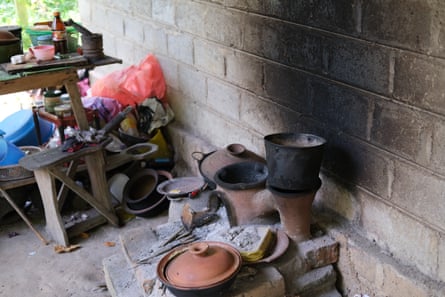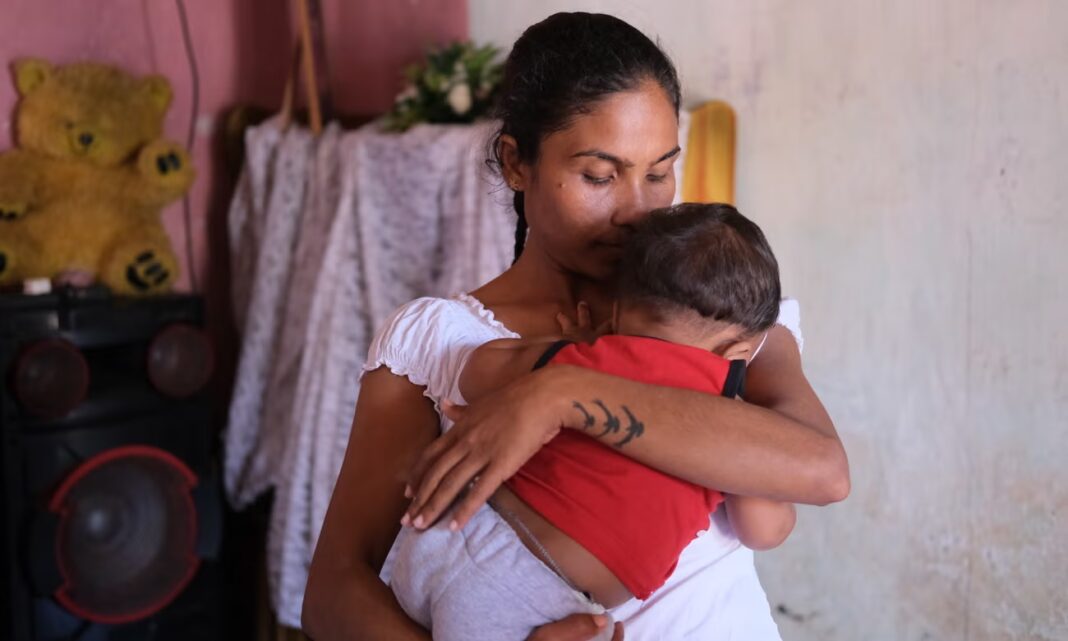Single mother Anne Roshel holds her nine-month-old son who was underweight at birth. Keeping him well fed is a daily struggle. All photographs by Zinara Rathnayake.
(The Guardian/ Zinara Rathnayake in Colombo) Since independence from Britain in 1948, Sri Lanka has rolled out several welfare programmes to boost food security, but Daniel says: “The progress made in recent decades seems to have now washed off.”
The crumbling economy, poor agricultural planning and falling buying power have made 6 million people, nearly 30% of the country’s population, food insecure. A survey by LirneAsia, a Colombo-based policy research institute, estimates that more than 4 million people have fallen into poverty in Sri Lanka since 2019, pushing the poverty rate up to 31%.
Duleeka Madhunamali, 26, lives in Naththandiya, south of Chilaw. Her husband cuts grass to earn 10,000 Sri Lankan rupees (£24) a week. It’s barely enough to feed their three children. “Even if we don’t have food, we make sure we somehow feed our daughters. But we can’t buy fish and eggs. It’s very expensive now,” Madhunamali says while repairing clay pots in their one-bedroom cement-block house. One pot earns her only 18 rupees – less than 5p.
“More and more families are adopting coping strategies to put food on the plate,” says Daniel. They compromise on nutritious food, eat less and skip meals. Protein sources like dal, eggs, fish and chicken are scarce and expensive, so most of them eat carb-heavy food like rice to fill their stomachs.
“We see parents compromise on their children’s education, and not send them to school because transport costs are high. So they use that money to put a meal on the table,” says Daniel.
Child malnutrition is seen all across the country. KS Chithra (who didn’t want to give her first name), is a public health midwife working in Bogawantalawa, a tea-growing region 90 miles east of Colombo. She monitors young children’s health, and says that most children from the tea estate families are severely underweight.
“Most mothers are impoverished tea pluckers who earn a daily wage,” she says. “So within three months of childbirth, they leave their infants to go to work. They don’t get to breastfeed their babies. Sometimes, infants maintain a healthy weight during breastfeeding but then their weight drastically drops because families can’t afford to feed them.”

Most estate families are now eating flatbread made from wheat flour to sate hunger. Government welfare programmes had been handing out free thriposha, a maize-based nutritious cereal, to all children under five and pregnant mothers every month across Sri Lanka. Now thriposha is only given to children above three now.
“And they only give it from time to time, not every month,” says Chithra.
Since the economic crisis, pregnant women in some estates haven’t received cash vouchers from the National Nutrition Programme that has helped pregnant women, says Chithra.
Children who have acute malnutrition in the estates now receive therapautic biscuits funded by humanitarian aid organisations. Unicef provides four months of small cash transfers of 6,750 rupees (£16) to 110,000 vulnerable families across Sri Lanka to help feed babies born from May 2021 to December 2022.

Back in Chilaw, Roshel has used Unicef funds to treat her son’s asthma and buy dry fish for her children. Her nine-month-old is now within a healthy weight range. But Chithra, the midwife, says: “The help from nonprofits is no longer enough because the crisis continues to put a toll on poor mothers.”
And Daniel, from Unicef, has a warning too: “Most impacts of child undernutrition are not visible yet in Sri Lanka, but the data and evidence show that the situation is grim, and you cannot wait any more..”
Courtesy of The Guardian
